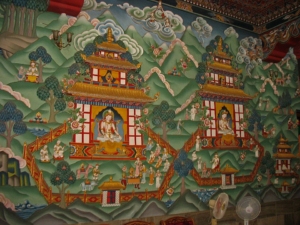In the Gaya district of Bihar, India, Bodh Gaya is the most revered pilgrimage site for most Buddhists around the world. This site is intimately connected to the life of Gautama Buddha: tradition claims that it was here, under the Bodhi Tree, that he attained enlightenment –the moment that forever changed his life, and the spiritual landscape of humanity.
The heart of Bodh Gaya is the Mahabodhi Temple complex, which was declared a UNESCO World Heritage Site in 2002. This temple marks the place where the Buddha sat in deep meditation, overcame the temptations that beset him, and finally attained bodhi –enlightenment. The temple itself, first built by Emperor Ashoka of the Mauryan Empire, is one of the most important spiritual landmarks in the world. Its soaring structure, surrounded by smaller stupas and shrines, draws pilgrims seeking to grasp the Buddha’s timeless wisdom.

Historically known as Uruvela, Bodh Gaya has long been a pilgrimage site for both Buddhists and Hindus. Its significance dates back to ancient, pre-Buddhist times, as evidenced by archaeological finds from the Mauryan period. Sculptures and artifacts found in the area attest to its long-standing role as a religious center. Even after being ravaged by Muslim-Turkish invasions in the 12th century, the site still is a mandatory destination for those seeking enlightenment.
Impressive as the Mahabodhi temple might be, Bodh Gaya’s heart is the Bodhi Tree, a direct descendant of the original tree under which the Buddha meditated. The tree is flanked by the Vajrasana, or “Diamond Throne,” which marks the site of the Buddha’s awakening. Pilgrims sit under the tree to meditate on the Buddha’s journey and teachings, expecting to find peace and enlightenment in this exceptional atmosphere. The area surrounding the temple complex is, as expected, quite serene.
In addition to Mahabodhi Temple, the site is home to other important landmarks –including a Hindu temple dedicated to Lord Jagannath, just a few meters away. This coexistence of Hindu and Buddhist traditions underscores the shared heritage and mutual respect among these two traditions, at least in some Indian regions.

As one of the four major pilgrimage sites associated with the life of the Buddha (along with Lumbini, Sarnath and Kushinagar) Bodh Gaya holds a unique place in Buddhist history. Every year, during the full moon of Vaisakh (April-May), thousands of pilgrims gather here to celebrate Buddha Purnima, the day commemorating the Buddha’s enlightenment.
For those planning a visit, Bodh Gaya is accessible by road, rail, and air. The nearest airport is Gaya International Airport, about 12 kilometers away, with flights from major cities such as Delhi and Kolkata. Gaya Junction is the nearest railway station, from where taxis or rickshaws can take you to Bodh Gaya. The best time to visit is during the cooler months of October to March, and if possible, during the festive period of Buddha Purnima, when the area comes alive with pilgrims from all over the world.





